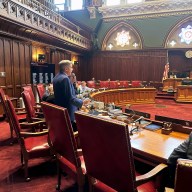OTTAWA – The stubbornly strong loonie is the major impediment to the Canadian economy rebounding more strongly from the recent deep recession, says Bank of Canada governor Mark Carney.
In a new warning about the currency that is approaching parity with the U.S. greenback, Carney says Canada would experience noticeably stronger recovery next year and in 2011 if the loonie had stayed at the 87-cent level the bank envisaged in the summer.
Carney said Thursday that’s why the bank made it clear this week that barring an unforeseen spike in inflation, it will keep interest rates at the historic low of 0.25 per cent until at least next July.
Carney said the central bank has several tools at its disposal, including intervention in the currency market, but didn’t specify which would be put to use.
“Intervention is always an option,” he said.
“Markets should take seriously our determination to set policy to achieve the inflation target. Markets sometimes lose their focus. We don’t lose our focus.”
The loonie closed 0.16 of a cent lower at 95.44 cents US on Thursday, but many expect it to hit parity with the greenback in the next few months, mainly because of weakness in the American dollar, which has dropped against most of the world’s major currencies.
A high loonie makes it cheaper to take U.S. vacations and buy imported goods. But it also harms the Canadian manufacturing sector because it makes exports of everything from minerals and metals to newsprint, machinery and lumber more expensive for buyers in the United States, Canada’s main export market.
Carney called the loonie’s persistent rise since July “the major downside risk” to the economy, noting that although the loonie was higher two years ago, the difference now is that it comes during a period of severe economic weakness.
His comments came after the central bank issued a comprehensive 28-page quarterly review of the global economy, showing a sharp rebound is underway, fuelled by government stimulus and the need to restock depleted inventories.
But in Canada, the strong burst in activity will last at most a few months more before giving way to the slow and difficult climb back from the deep hole that the recession dug over the past year, the review adds.
The bank is more optimistic about the second half of this year than it was three months ago, noting modest employment gains in August and September.
In a supporting report, Statistics Canada announced that retail sales jumped 0.8 per cent in August to $34.5 billion, largely as a result of strong activity at new car dealerships and at gas stations.
“When the labour market fares well, good things tend to happen to the rest of the Canadian economy,” said CIBC economist Krishen Rangasamy.
The domestic economy is now expected to record a two-per-cent gain in the third quarter – the July-September period – and 3.3 per cent during the last three months of this year. The Bank of Canada’s July forecast called for growth of 1.3 per cent and three per cent, in the third and fourth quarters respectively.
A number of things have broken right for Canada to make this happen. Commodity prices, particularly oil, have firmed up, financial markets have stabilized faster than thought, and the global economy, particularly China, has rebounded quicker and stronger than expected.
And consumers have bounced back strongly, although the manufacturing export sector continues to struggle. There are also concerns about how future government restraint might erode growth as Ontario, Alberta and the federal government warn of spending curbs to cope with large deficits.
That will be more a problem after 2011 when many temporary stimulus measures reach sunset and governments try to work off massive deficits they have compiled, said TD Bank economist Pascal Gauthier. But he believes governments will play it by ear when they start withdrawing stimulus, or enact deep spending cuts.
“I don’t think the governments themselves could cause a recession because by that time we will have some clarity on whether the private-sector recovery has some legs in it,” he said.
For the next two years, however, it will be the loonie that cuts away at economic growth, the bank’s outlook argues.
Even if the dollar averages 96 cents US, and does not go above parity as some expect, the impact on the export side of the economy will severe enough to restrict growth to 3.0 per cent in 2010 and 3.3 per cent in 2011, a smaller bounce than normally follows deep recessions.
“Over the balance of the projection period, growth is slightly lower, reflecting the effect of the higher value of the Canadian dollar,” the bank said, noting that a high dollar will make life difficult for manufacturers to sell their products in foreign markets.
On Tuesday, the bank issued a similar warning when it reaffirmed, in strong words, that it intends to keep interest rates at the historic low of 0.25 per cent at least until next summer.
The language had the desired impact of driving the loonie down nearly two cents Tuesday.
Still, no economist believes Carney strong warnings will be sufficient to keep the loonie grounded for long. In the final, analysis, the bank believes it has already set back by three months the recovery period.
It won’t be until late 2011 – two full years from now – that Canada’s economy will again be hitting on all cylinders, the bank says.
The report cautions that growth assumptions – modest as they are – are still contingent on the world continuing to enact the right policies, including the building up of reserves in U.S. and European banks, and China and other emerging economies taking on a greater role as consumers rather than simply dumping exports into the U.S.
The bank sees little danger of what some bear economists fear will be another recession in 2011 when governments are expected to stop spending trillions of dollars to stimulate the economy..
At present, almost all of the rebound around the world is due to government spending and extremely low interest rates, especially in the United States.
But the bank notes there is some evidence of modest self-sustaining private demand.
As well “necessary adjustments on both the real and financial sides of the global economy are under way,” it added.
“The risks to the outlook remain elevated, although they have diminished somewhat since the July report, with accumulating evidence of a recovery in the global and Canadian economies,” it said.
















